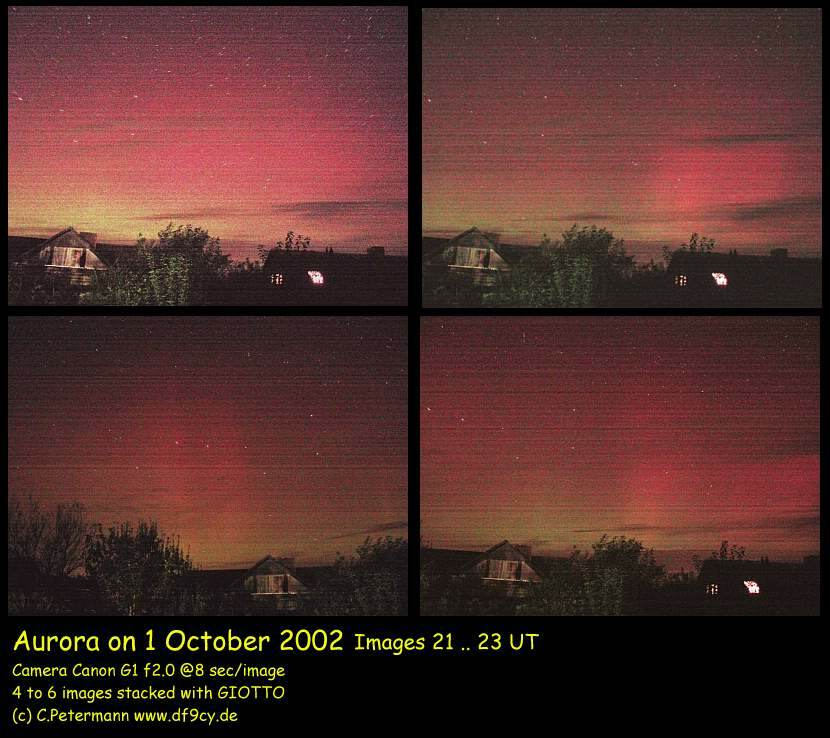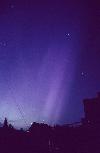|
Astrophotography - Aurora or Northern Light Images |
We sometimes have aurora in Northern Germany. They occur mainly in spring or
in autumn. I have been frequently able to see them and to take photos of them.
But I had to get some experience to make good photos. The one shown here was a
bit faint and I enhanced it a bit.
Auroras can be monitored by amateur radio. Radio waves are reflected by the
aurora phenomena. I have made many hundred of contacts via aurora on frequencies
from 14 MHz up to as high as 432 MHz. I even made my greatest distance (DX) on
432 MHz via aurora reflection with a radio amateur close to Moscow.
29 May 2003
On the evening of 29 May a major Aurora event occurred. I made a number of images either with my G1 DigiCam and my Nikon F90. Here is a selection of images of this major event.
29 May 2003 AURORA

1 October 2002
Here is a collection I made mith the G1 digicam oroud 21 to 22 UT in the evening of the 1 October 2002. Even the Aurora was quite bright, the G1 camera has serious problems with these kind of images. The images you see here are each a stack of 4 .. 6 single exposures of 8 seconds. You also see the strange noise the camera produces.

The Night 17 August 2001
Here are 4 images I made with my Canon G1 Digital camera. The Aurora was not very strong and I enhanced
the images quite a lot. Click on the image to get further.

The Night 15/16 July 2000
Amateur Radio showed activity since the early afternoon of the 15 July 2000. But sky was overcast. The radio reflections
disappeared at ca 1800 UT but returned soon again very strong. At 2200 UT local time clouds were gone and it was dark enough to see the Aurora even with a full moon in the south..
I made about 100 contacts in the 50 MHz Amateur Radio band with stations all over central Europe. Later I heard, that amateurs
from Oslo had NO visual display. Here are some of the nicest images I made that night. I just received my slide scanner from Jenoptik JS11.
These are the first scans.
Select stamp size images to get a better resolution
 |
- Instrument: NIKON F90 - Tokina 2.6 .. 2.8 / 28 .. 70 mm
- Film: AGFA CTX100 100 ASA - Slide
- Exposure time: ca 60 sec
- Date: 15 July 1000
- Notes: A view into zenith; The bright star is VEGA
|
 |
- Instrument: NIKON F90 - Tokina 2.6 .. 2.8 / 28 .. 70 mm
- Film: AGFA CTX100 100 ASA - Slide
- Exposure time: ca 60 sec
- Date: 15 July 1000
- Notes: The Amateur Radio Antenna against the Aurora curtain in the sky. On Top the 50 MHz Antenna and below you see the 28 MHz 3 Element. The bright star is VEGA
|
 |
- Instrument: NIKON F90 - Tokina 2.6 .. 2.8 / 28 .. 70 mm
- Film: AGFA CTX100 100 ASA - Slide
- Exposure time: ca 60 sec
- Date:15 July 1000
- Notes: The view to the west at about 2300 UT
|
 |
- Instrument: NIKON F90 - Tokina 2.6 .. 2.8 / 28 .. 70 mm
- Film: AGFA CTX100 100 ASA - Slide
- Exposure time: ca 60 sec
- Date:16 July 1000
- Notes: The east at ca 0130 UT already in morning dawn. Right above the building you see rising Jupiter and Saturn.
|
More Aurora Images
 |
- Instrument: KIEV 19 - Tokina 2.6 .. 2.8 / 28 .. 70 mm
- Film: Kodak Elite II 400 ASA - Slide
- Exposure time: 20 sec
- Date:27 August 1998 / ca 0030 UT
|
 |
- Instrument: KIEV 19 - Tokina 2.6 .. 2.8 / 28 .. 70 mm
- Film: Kodak Elite II 400 ASA - Slide
- Exposure time: 20 sec
- Date:27 August 1998 / ca 0130 UT
|
 |
- Instrument: Practical Super TL, 2.8/50mm
- Film: Fuji RD 100 ASA - Slide
- Exposure time: 1 min
- Date:October 1992 / ca.2000 UT
|
 |
- Instrument: Practical Super TL, 2.8/50mm
- Film: Fuji RD 100 ASA - Slide
- Exposure time: 1 min
- Date:November 1992 / ca.2000 UT
|
|
Text and All Images are Copyright by Christoph Petermann DF9CY
|
GO (back) and visit my
homepage





